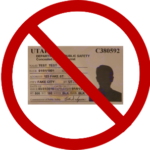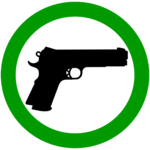
Constitutional Carry
If you are at least 21 years old and not a prohibited person as described in 76-11 Part 3 or 18 U.S.C. 922(g):
- It is LEGAL to carry any lawfully owned firearm loaded and concealed without a concealed firearm permit, and no law requires the firearm to be concealed.
- It is ILLEGAL to possess a firearm in State Prohibited Areas or Federal Prohibited Areas.
- It is ILLEGAL to possess a firearm on any school premises unless you have a valid Utah concealed firearm permit.
- It is ILLEGAL to have a loaded rifle, shotgun, or muzzle-loading rifle in a vehicle unless you have a valid concealed firearm permit and it is your vehicle or you have consent from the owner of the vehicle. This means you can only have a loaded handgun in a vehicle.
See other Constitutional Carry States.

Open Carry
This section only applies if you are 18 to 20 years old, not a prohibited person as described in 76-11 Part 3 or 18 U.S.C. 922(g):, and you do not have a valid provisional concealed firearm permit:
- It is LEGAL to open carry (visible at all times) any lawfully owned firearm, unloaded in public. See 76-10-502 and an explanation below.
- It is LEGAL to carry any lawfully owned firearm loaded and concealed;
- In your home, including any temporary residence (hotel) or camp (including the tent), and on your real property.
- In your vehicle or a vehicle with the owner’s consent. Handguns ONLY
- In your business or a business under your control. This can be explained as the possession, direct or indirect, of the power to direct or cause the direction of the management and policies of a person, whether through the ownership of voting securities, by contract, or otherwise. A member of an organization or an employee of a company who has significant sway in the decision-making process.
- While hunting, as long as you are not within the limits of a municipality (city) and not on any highway (road).
- On duty as an armed security officer with a valid armed private security officer license.
Laws
53-5a-102.1. When a firearm is considered to be loaded.
For the purpose of this chapter, a firearm is considered to be loaded if the firearm meets the conditions described in Subsection 76-11-102(1).
76-11-102. When a firearm is considered to be loaded.
(1) For the purpose of this chapter:
(a) a firearm is considered to be loaded when there is an unexpended cartridge, shell, or projectile in the firing position;
(b) handguns are also considered to be loaded when an unexpended cartridge, shell, or projectile is in a position whereby the manual operation of any mechanism once would cause the unexpended cartridge, shell, or projectile to be fired; and
(c) a muzzle loading firearm is considered loaded when the muzzle loading firearm is capped or primed and has a powder charge and ball or shot in the barrel or cylinders.
(2) If a provision of this chapter does not specify that the firearm in the prohibited or allowed conduct is loaded or unloaded, the prohibited or allowed conduct includes if the firearm is either loaded or unloaded.
- Semi-Automatic:
- A loaded magazine in the firearm, no round in the firing position (chamber is empty).
- Must have two mechanical actions to fire;
a. Rack the slide to load a round from the magazine into the chamber.
b. Press the trigger to fire the round. A “thumb”, “grip”, “trigger” or any other type of safety feature is not considered a mechanical action.
- Double Action Revolver:
- Ammunition can be loaded in the chambers of the cylinder, with no round in the firing position. This means the chamber behind the barrel must be empty. The next chamber must also be empty. Ensure you know in which direction the cylinder rotates (clockwise to the right, counterclockwise to the left).
- Must have two mechanical actions to fire;
1. Pressing the trigger once will rotate the cylinder with the empty chamber and place another empty chamber in line with the barrel.
2. Pressing the trigger a second time will rotate the cylinder, position a loaded chamber in line with the barrel, and fire the round.
53-5a-101.5. Definitions.
As used in this part:
(4) (a) “Concealed firearm” means a firearm that is:
(i) covered, hidden, or secreted in a manner that the public would not be aware of the firearm’s presence; and
(ii) readily accessible for immediate use.
(b) “Concealed firearm” does not include a firearm that is unloaded and securely encased.
- 53-5a-102.2. Open and concealed carry of a firearm outside of an individual’s residence.
- 53-5a-108. Individuals who are exempt from certain weapons laws.
- 53-5a-312. Armed Forces — Permit requirements — Exemptions.
- 58-63-307. Use of firearms. (For Armed Private Security Officers)
- 76-11-202. Unlawful carrying of a concealed firearm by an individual under 21 years old.
- 76-11-203. Concealing an unlawfully possessed short barreled shotgun or short barreled rifle.
- 76-11-204. Unlawfully carrying a firearm in a vehicle.
- 76-11-220. Carrying a loaded firearm on a public street by an 18 to 20 year old.
- 76-11 Part 3. Persons Restricted Regarding Dangerous Weapons
